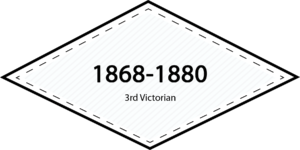
“New World for Women”
Wild West discovered among monarchies & bustles

—— ERA IN BRIEF ——
This was a time of change for women when they had many different choices in life & in fashion. With women becoming more active participants in the world at large, they also became more individualized. While high fashion under the leadership of Queen Victoria of England still dictated specific designs focusing on the rear end & a long torso, there was a vast range of materials & designs available to women of all classes & occupations for garments: from couture tailored ensembles to quick catalog corset orders. Influences from around the world infused new color, fabrics, & concepts into clothing. Due to a more active lifestyle, sportswear, work wear, & travel wear along with stirrings of a movement in fashion that steered away from the constrictive structures of undergarments arose as women emerged from their roles inside the home.

—— PORTRAITS OF REAL WOMEN OF THE TIME ——
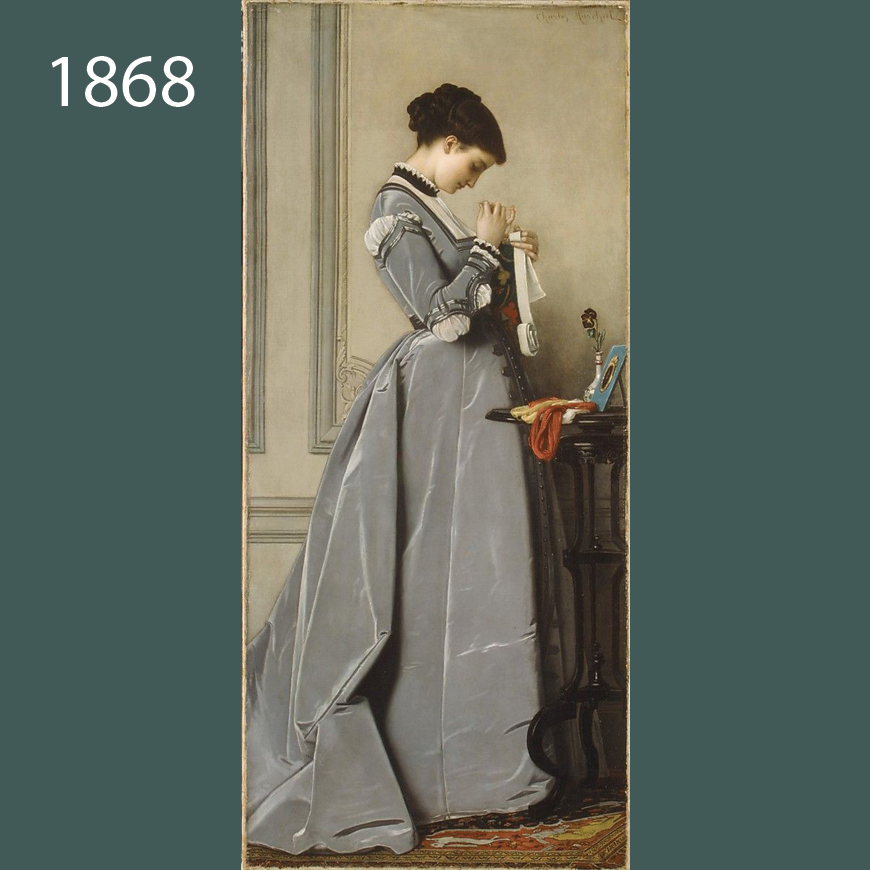
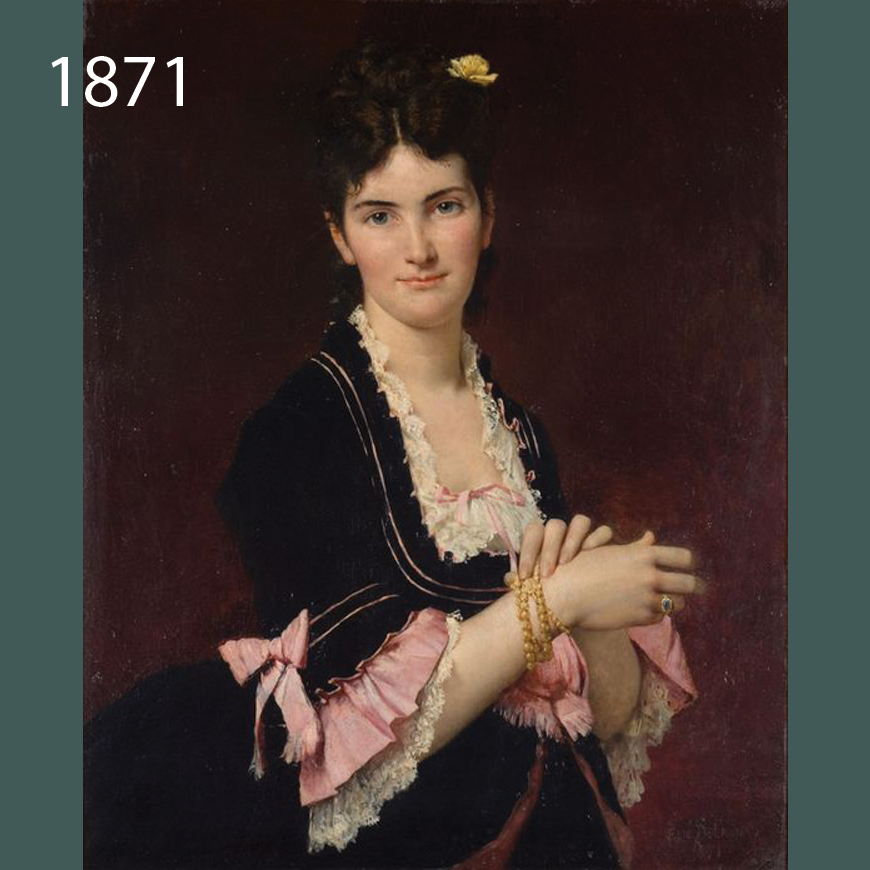
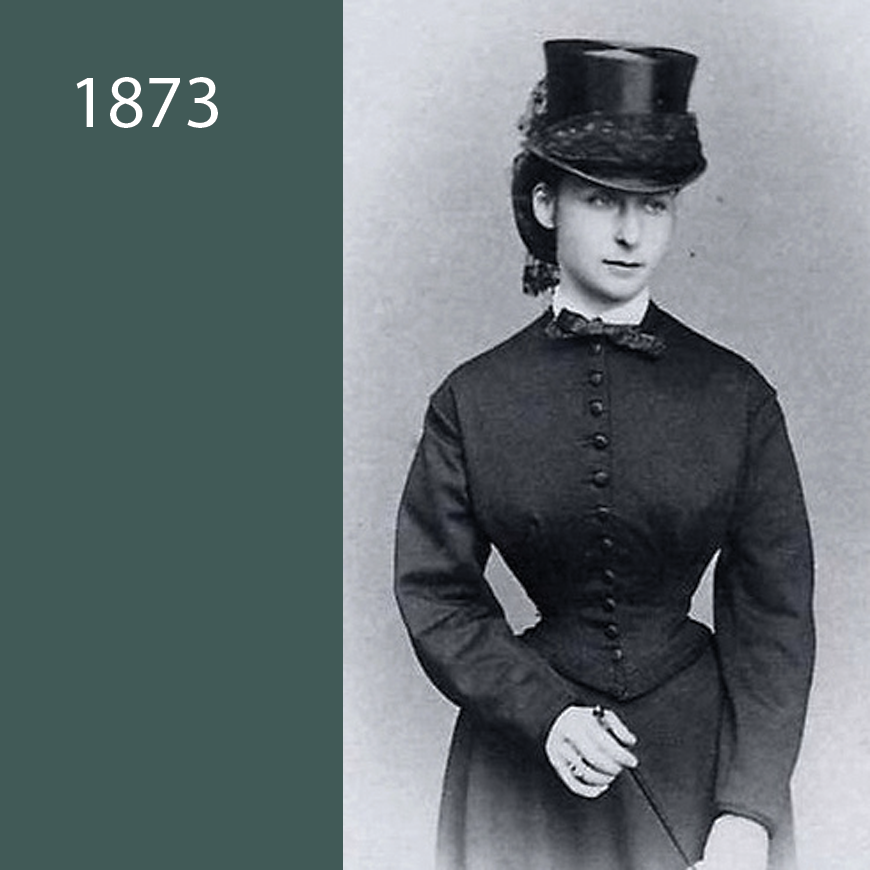
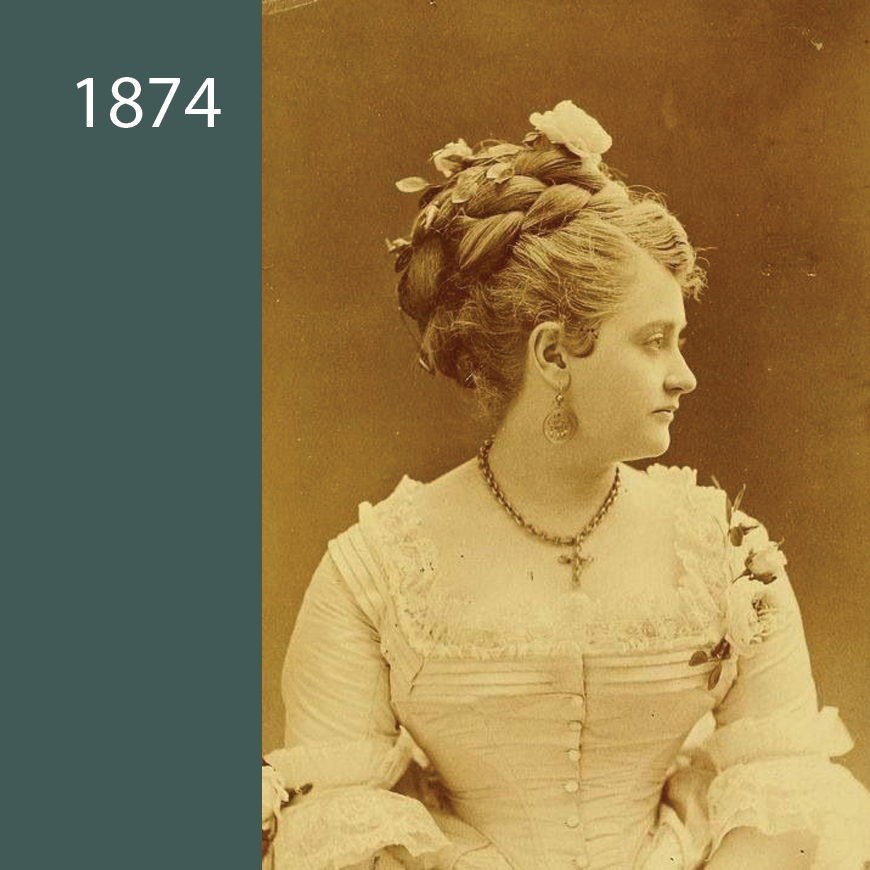
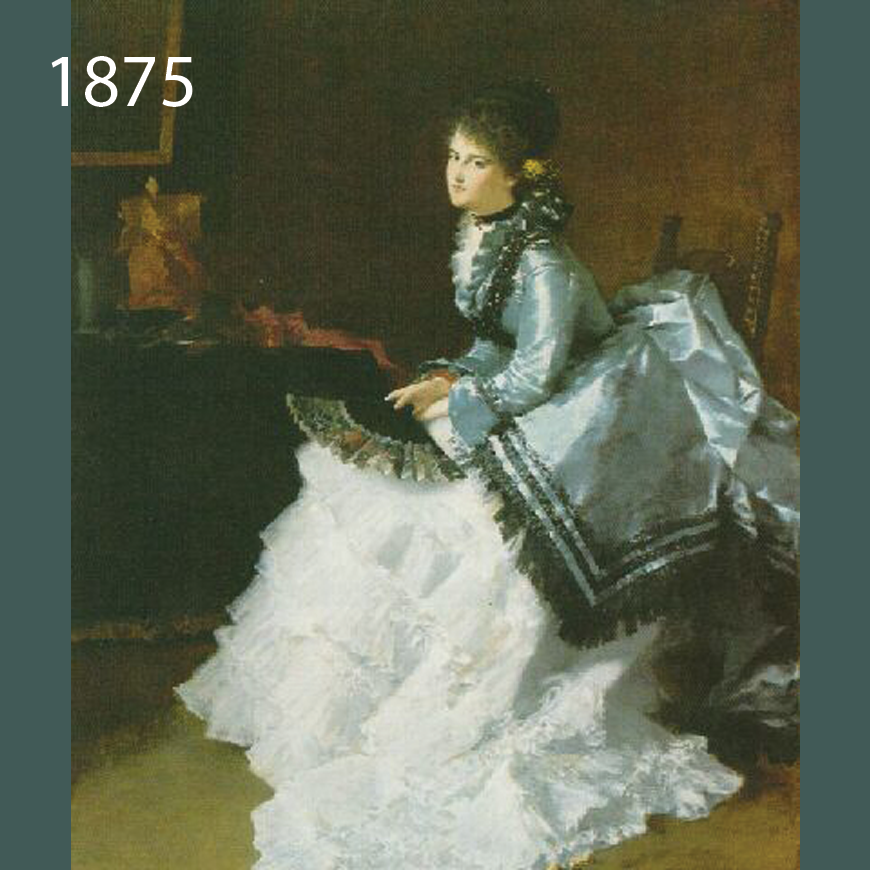
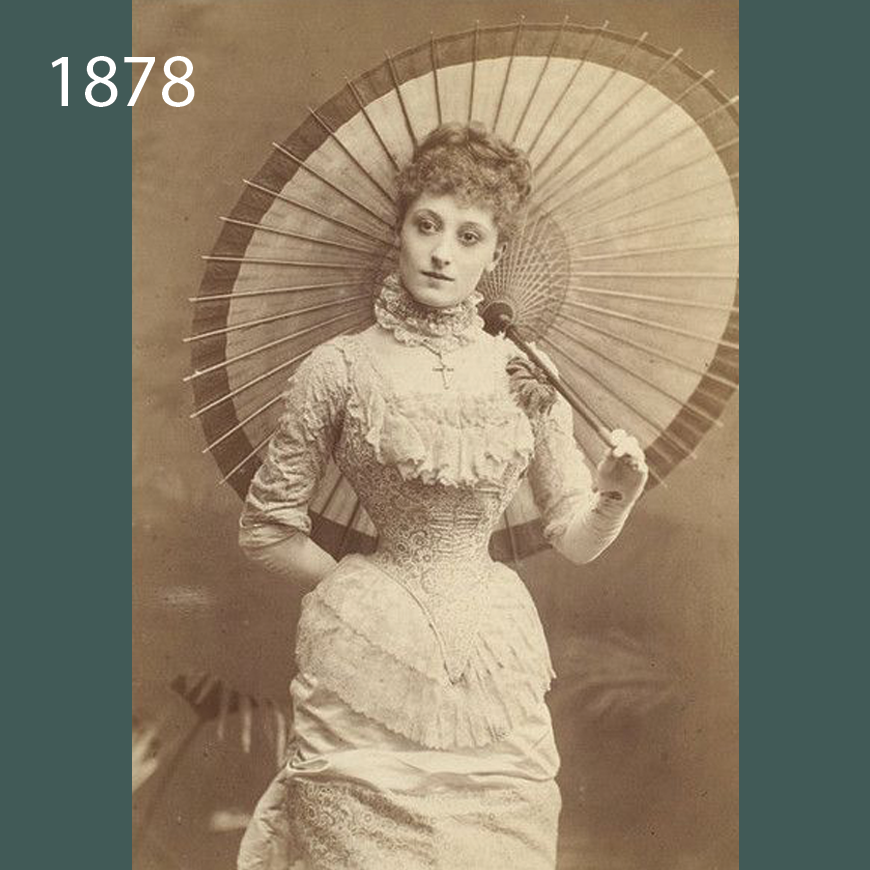
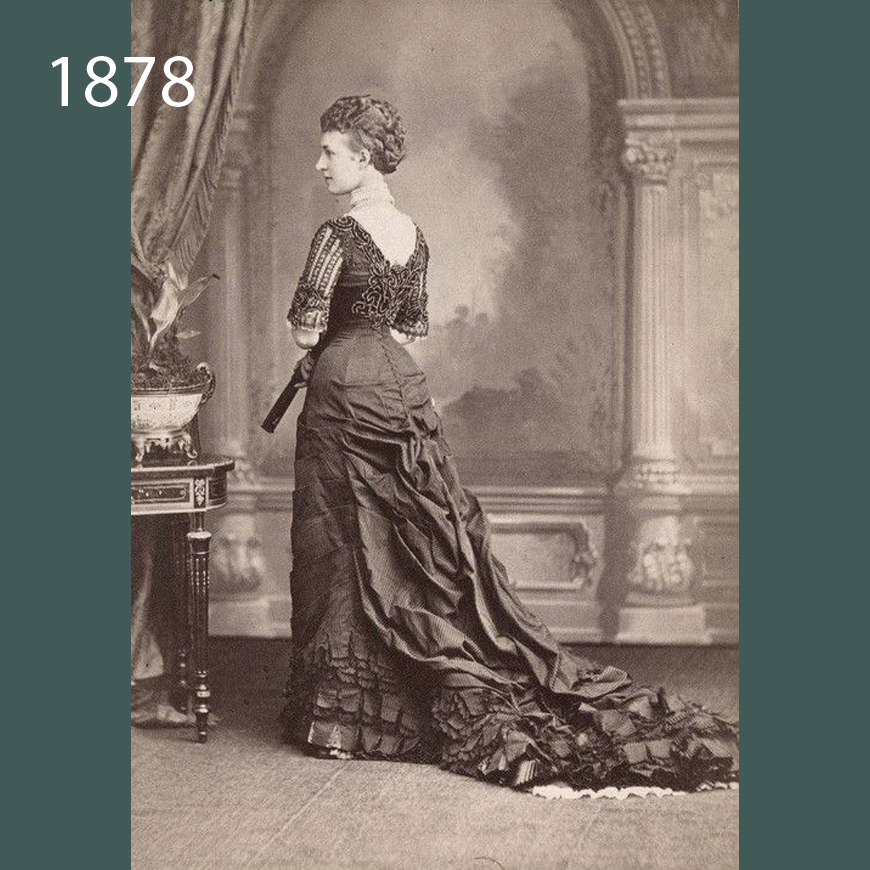
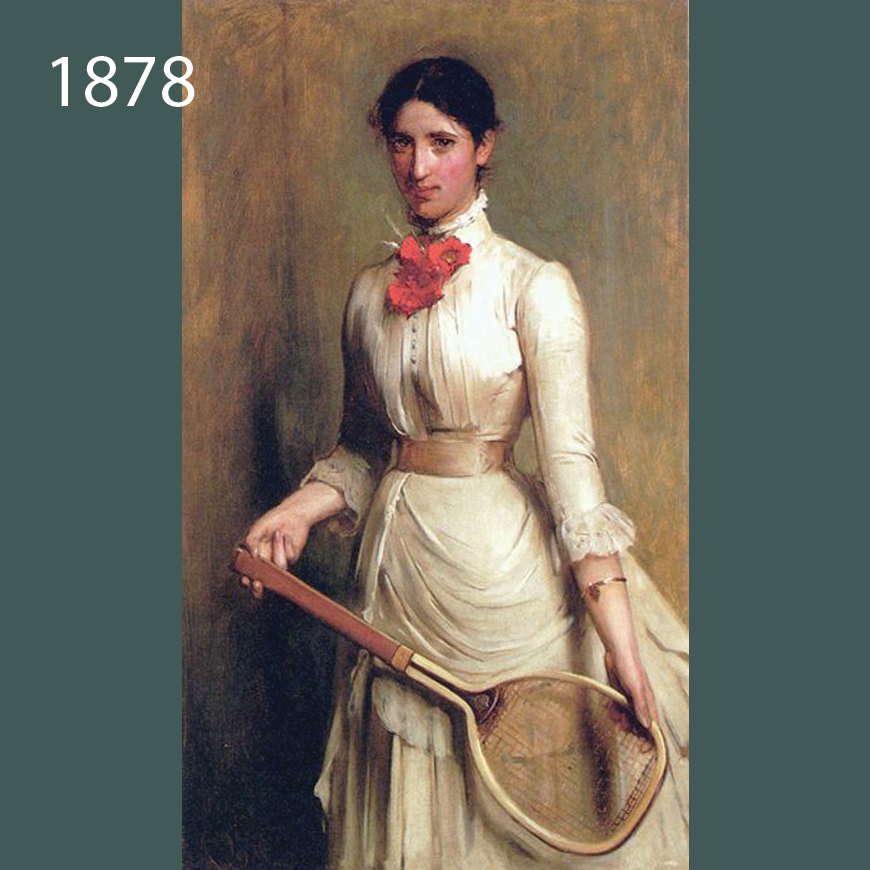
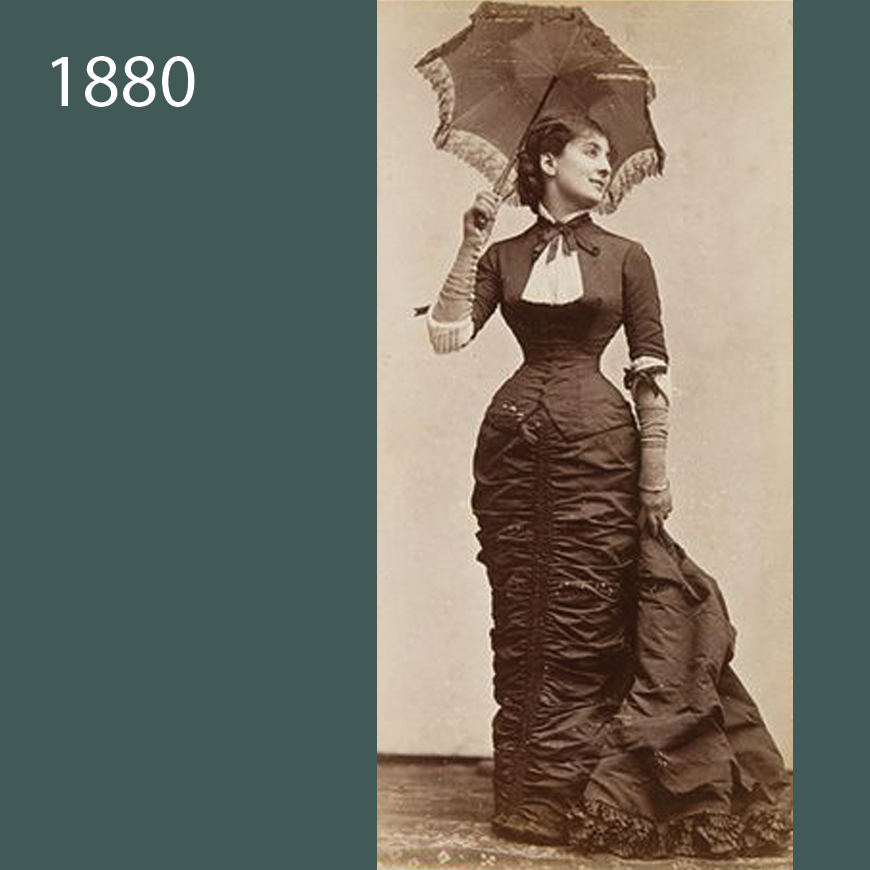
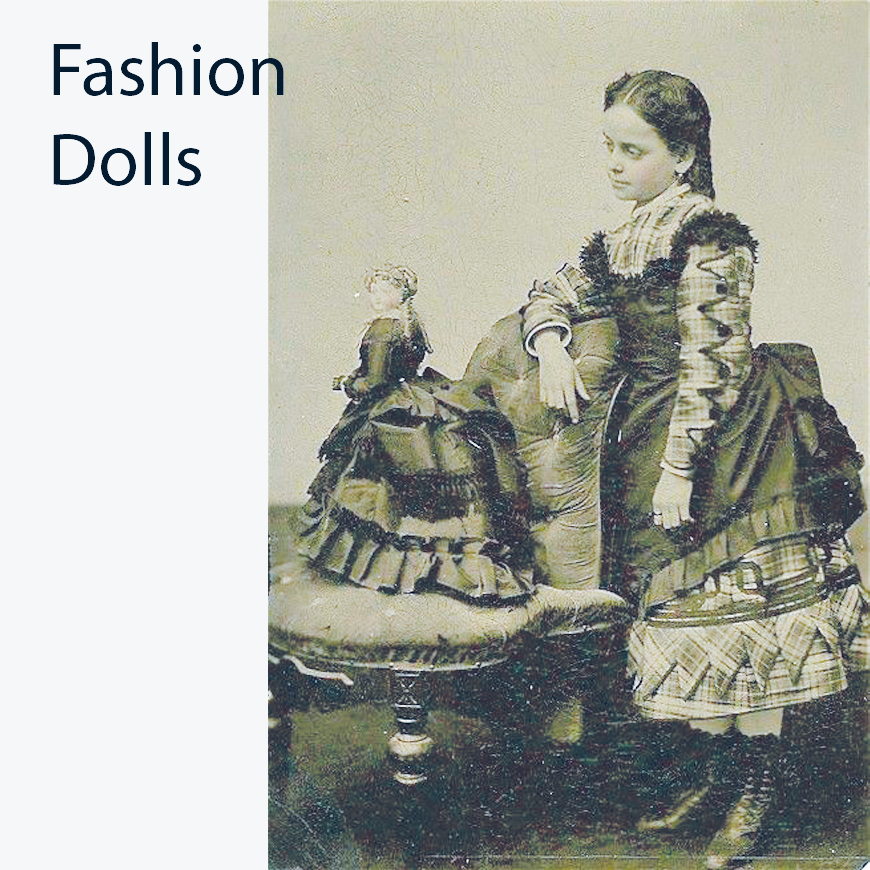

—— WORLD SITUATION ——
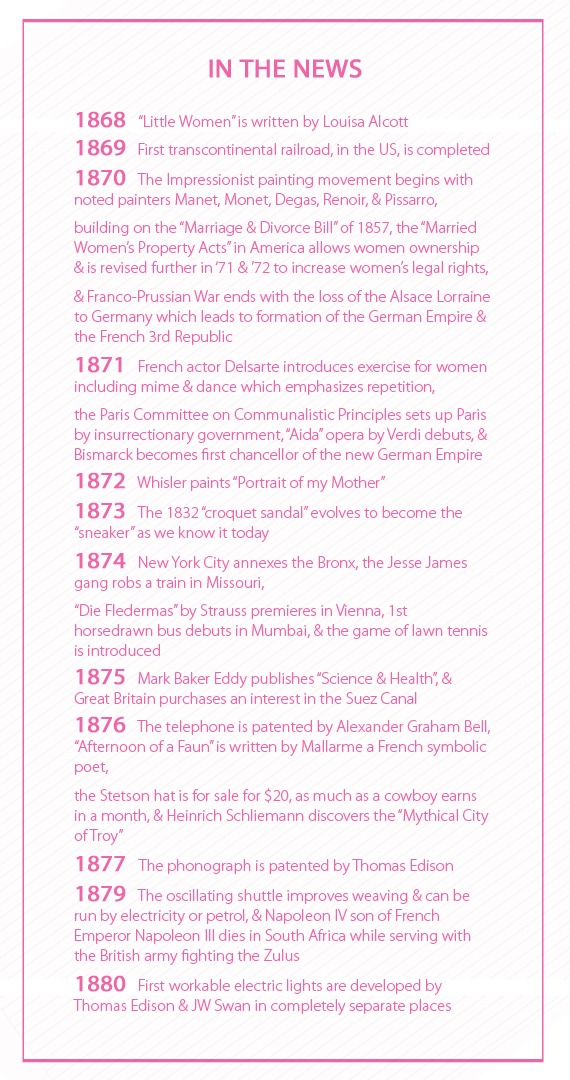
- The French Empire collapsed in 1871 when the united German Empire was proclaimed in Versailles, & when Germany replaced France as the dominant European power
- Empress Eugenie of France was forced to go into exile, ending France’s dominance in the world & in fashion
- Eugenie did visit England where she exerted influence, plus she was allowed to return to France as long as she didn’t involve herself in politics
- War was ended in most countries around the world, as boundaries had been at least temporarily established
- It was a relatively peaceful time as countries recovered from recent conflicts
- Japanese isolationism ended with the dissolution of the Shogun era, allowing communication & trade to flourish between Asia & the rest of the world
- Trade flourished worldwide
- New class structures were emerging
- Inside many countries the after effects of war created rift between classes, & there was a resurgence of class distinction
- Poverty & corruption reigned during recovery
- The first transcontinental railroad in the US brought people & ideas together
- European railroads changed class structure in a different way, as all people of all classes traveled together
- Communication was improving as Bell invented the telephone in 1876 & the telegraph transmitted across the ocean on cables laid the previous era
- People lived in cities in apartments
- America already had a large middle class; Europe had an emerging middle class made up of successful tradesmen
- America was expanding into the West. Western influence increased as railroads were laid, & access to remote areas increased
- The American West was contributing a “counter culture” to the fashion of Europe, creating exchange of ideas for all classes & new ideals of a much stronger “ideal woman”
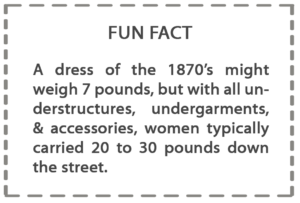
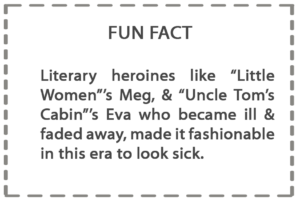

—— INTERESTING FACTS ——
REBELLION & ACTIVITY
- Women were starting to rebel against the dictates of Victorian fashion
- Practicality made previous styles difficult to maintain due to women’s greater mobility
- Women had greater participation in social, political, scientific, & artistic endeavors than they had ever before
- Women of all classes were more physically active
- Women of the middle class were working outside the home
- Upper class women were participating in sports & leisure activities that took place further & further from home
- Women were exercising. Golf, tennis, lawn croquet, roller skating, ice skating, & cricket demanded more flexible clothing
- Horsemanship continued to be the place women could get out & be independent
- The “Amazon Horse Woman” became an ideal of this time
- The “Amazon” always wore a top hat with veil, man’s tie & collar, a wasp waisted version of a man’s coat, masculine trousers under a very long skirt, boots, & her corset of course
- There were riding corsets that were shorter & had seaming to allow more movement of the torso, arms, & shoulders
- Women would continue to wear a long skirt even to ride a horse well into the 1900’s
- The bicycle changed everything. Women were allowed to pull up their skirts in public while riding, ending the mystery as to whether women had legs or not
- The gym suit was invented in 1871 by a French actor. It consisted of a sleeveless knee-length tunic worn over a blouse & bloomers
- Men were not allowed to be present when women wore their gym suit or exercised in a gym
- Women were permitted (by men) to use wands & dumbbells to exercise
- A favorite & permissible exercise for women to do publically was mime
- Even in this day of more permissible activity, women were never to run
- In the case of emergency, a woman was required to faint. They practiced fainting regularly
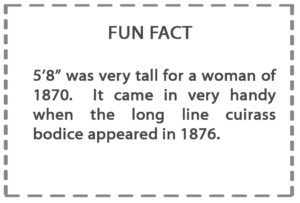
TRAVEL & DISCOURSE
- Increased travel due to trains & improved mass transport like the horse-drawn bus, meant the crinoline & elliptical hoop were totally impractical
- Even with new “reticulating” hoop styles that could be brought up like a window curtain, or turned sideways & collapsed, women did not want the cumbersome devices in their new, mobile worlds
- A crinoline era ensemble typically included 10 petticoats, large hoop, long boned dress adorned with beads, hat full of flowers, ribbons, veiling, & feathers
- They did not want to haul all of that weight around on a trip
- With new ideas coming from countries like Japan, women saw there were options to the restrictive garments of daily Victorian wear
- In 1875 with the end of Japanese isolationism, goods, prints, concepts, & designs from that country became wildly popular in the rest of the world, but particularly Europe & America
- As a departure from the generalized trade of department stores, & catalogs that carried everything from clothing to farm implements, Japanese stores specialized in selling Asian goods
- In England & France, kimonos & Asian produced items flourished
- Asians introduced to Europe design based on the natural forms of the world
- Artists embraced the new merging of European & Asian cultures, figures, forms, & concepts
- Renowned Impressionist painter Claude Monet depicted his wife in 1876 “a la Japonaise”
- Notoriety of the Monet painting developed a visual standard or artistic, Asian-inspired dress for which women strived
- In Europe & America, there were also many stores with goods from other countries besides Asia too
- Foreign stores capitalized on nostalgia from Medieval, Renaissance, Roccoco, Georgian, & Regency eras
- They sold items from every era & style of the past
- Typical ancient cultural goods included classic Greek tunics & gowns, Egyptian collars & jewelry, embroidered coats from China, fans, & imported silks
- Mail order was also a HUGE business, especially in America
- Mass produced goods had a bad reputation by now as being of poor quality
- Mass production & catalog sales also had the downside of difficulting in finding a size that fit
- Buying catalog clothing was by trial & error, as size standards were still being developed & refined
- A Montgomery Ward ad of 1875 said “give us your age & description of your general build, & in 9 cases out of 10 we’ll give you a fit.”
- Some people sent their astrological signs to help with fit on mail order clothes
- Henry David Thoreau wrote at this time: “Beware of all enterprises that require new clothes”
- It could be time consuming & costly to be a fashionable woman of this era
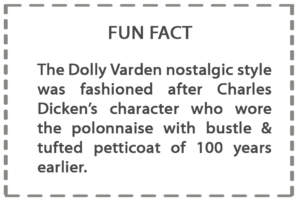

—— FASHION TRENDS ——
TEA OR TENNIS
- Fashion was no longer directed by Court. Hardly anyone paid any attention to Court for anything any more
- The French Court no longer had influence, although the French designers
- Although Paris was still the fashion hub of all European influenced countries, the gay sociable & well-dressed Edward, Prince of Wales with his Princess Alexandra had the most influence at the time
- Americans in particular became fascinated with the Prince & Princess after they visited America in the 1860’s
- Edward & Alexandra had social connections with the president because his daughter had attended school with their relative
- They were friends with other influential people of the US, & visits always caused a stir at all levels of American society
- Alexandra’s key fashion influence was the cut of the dress
- Her newly introduced straight & simple silhouette evolved through the next 10 years to become what is now called the “princess line”
- Taking clues from this royalty, fashion was then initiated by professional designers who marketed heavily to those who could afford it
- Word of fashion trends was spread by mouth, except in high society
- The wealthy had expensive color magazines with patterns included
- Drawing rooms, high teas, parties, & social occasions were places to parade “high” fashion
- Wealthy women had specific & different outfits for each of morning, noon, night; as well as special outfits for every activity such as riding, formal dinner, afternoon tea, or walking
- It was fashionable to be “well rounded” (fat)
- This was convenient because while many women were exercising, most of the upper class spent most of their social time eating
- Because the ideal woman was fat, bodices began to include a high collar which hid double chins
- Because of the high collar, hands tucked in muffs, & because she wasn’t supposed to have legs, Victorian women of this era had a “mincing” gait as she put one foot in front of the other
- Fashionable clothing was available to everyone to some degree. While the high class bought from the custom tailor houses on Savile Row in Paris, the middle & lower classes could buy similar apparel in department stores & catalogs
- Working women were finding more functional apparel through mass distribution
- Peasant women had access to the same fashions as others
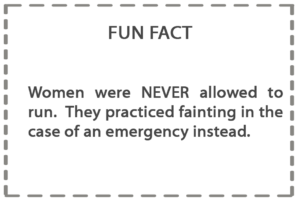
EMULATION & INFLUENCES
- The textile industry was booming, & with further improved power looms of 1870 plus more available materials due to improved transportation through shipping, along with new dyes, mass production was finally meeting the demand for new clothes
- Garment construction was completely standardized except with specialty designers & shops
- “Bulk sizes” were premade in multiples
- The sewing machine, further improved for lighter & faster work, enabled seamstresses to complete clothing very quickly
- The sewing machine was so fast that more flounces, frills, & otherwise time-consuming stitchery could be added to clothing for little cost, leading to an explosion in added “frippery” to all garments
- Because of easy availability & reasonable cost, a new attitude emerged that clothing could be somewhat expendable
- It was no longer common to hand down clothing through 6 or 7 exchanges
- Clothing itself had lost value as a commodity, although fashionable design increased in value
- The huge clothing resale business & the street cart used clothing peddler disappeared entirely
- Couture houses such as those founded by Charles Worth in Paris in the 1850’s were flourishing
- High Fashion Houses provided coveted high quality custom tailored clothing to those who did not want ready-made or mass produced
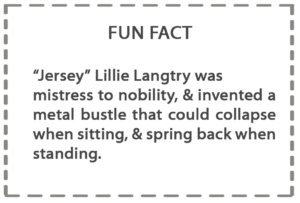
ODD CHARACTERS TAKE THE LEAD
- Literature like “Little Women” by Louisa May Alcott & “Uncle Toms’ Cabin” created popular heroines who would fade away gracefully & die
- Following the demise of poor Little Beth & Little Eva, who gradually & gracefully just faded away in their respective books, it became fashionable to look sick
- Dolly Varden, Charles Dicken’s character of a coquettish locksmith’s daughter from the book “Barnaby Rudge”, set a fashion trend in 1869 called the “Dolly Varden”
- Dolly wore delicately flowered dimity (cotton) dresses with a polonaise, bustle, & tufted petticoat
- Dolly brought back all the nostalgia for the Georgian era
- This wistful thinking about former eras had designers replicating styles of the 1700’s & early 1800’s for women who could afford them
- French “Haute Couture” designer Charles Worth introduced a “modern” princess gown at this time
- Worth’s “novel” idea was a one piece poufed overskirt that was worn over a visible petticoat
- Oddly, Worth’s innovation looked exactly like the polonaise of 1775, yet he claimed it was completely his own original concept
- Cosmetics & dangerous concoctions emerged, much like those used in the prior era to keep skin looking pale & wan
- Women wanted the pale & delicate look of their literary & historical heroes
- There were also fashion leaders for those who wanted to embrace the strong, athletic, & robust ideal woman that was emerging
- Lillie Langtry, called “England’s most beautiful woman” because of her voluptuous curves & charms, became a fashion icon
- Women, especially those of large stature, fullness, & curves copied her
- Lillie was a tall 5’8″ for that time, & had what was considered an unattractive “Greek facial profile”
- Despite what was considered an “ugly face”, she was immensely popular
- Her fame began when she became mistress to the Duke of Wales
- Her later affair with King Edward VII brought her to global fame & notoriety
- Lillie was called “Jersey Lilly” because of her invention, working with a French designer, of a tubular dress of a knit fabric (“jersey”)
- The “jersey” took 2 people to squeeze Lillie into it
- Lillie was an inventor & an innovator. She solved the problem of sitting & standing in a large bustle, by inventing a collapsible metal version with springs that would pop back out when you stood up
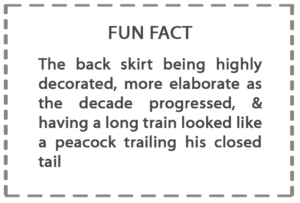

—— SPECIFIC FASHIONS ——
EXPLANATION OF BUSTLES 1860-1890
- 1) Crinolette became Bustle 1860-1870
- A crinolette was a small wire unit that was not strong enough to support much fabric
- It ran down the back of the legs to the knees, & its main purpose was to hold draped fabric out so one could walk
- 2) Fishtail small Bustle #1 1870-1880
- This “first bustle era” had huge extremes, flounces, bows, & understructures
- The 1868 (“First”) bustle was big, soft, high, & constructed mostly of draping
- The bustle looked like a fish or lobster tail
- While there was a small metal structural bustle at the top, most of the “tail” & “train” were actually made of folded & flounced fabric (as opposed to the later full tail structure)
- Full skirts were pulled to the rear & supported by a part wire/part tape or fabric wire cage
- By 1876, this bustle was about 12″ in depth. It was the antecedent to the huge bustle to come next
- “Natural Form” 1878 was the low point for this type of bustle
- Overall the gown was more tailored after 1878, & deleted much of the trim, ribbons, & ruffles of 1868-1878
- A small peplum was added on top of the bustle, especially later towards 1883 during the transition time into the large bustle era
- Bows were also worn over the bustles & above the draped overskirt
- 3) No bustle 1881-1883
- There was a brief era with a slender profile without using an understructure or bustle
- Instead of a structure, fabric of an overskirt was looped up & draped over the underskirt
- Draping & looping was done at this time with tapes & hardware similar to today’s cording on window shades
- Instead of being wired as it was before & after this brief respite
- 4) Big horse-flank bustle 1884-1889 (including transition time leading up to 1884)
- Huge structures created a “table” straight out the back of the body
- These were hard wired with many designs & improvements through the period
- Dresses were more tailored in general, with less flounces but increasingly more trims
- As with the earlier crinolines, the addition of a carpentered structure meant less undergarments were needed to hold the dress out
- Less fabric & petticoats were needed
- Less bows & overdrapes & frills were needed to get the shape
- These required many modifications of behavior as it was somewhat like wearing a table behind you
- Huge structures created a “table” straight out the back of the body
- 5) No bustle forever 1890
-
- New attitudes & activities of women, along with designer influence in a changing world, ended the bustle’s reign
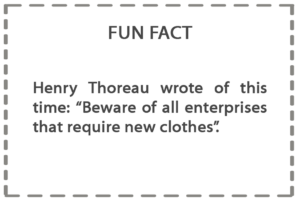
EVOLUTION OF THE BUSTLE: #1 FISHTAIL
-
- The 1870 to 1880 decade is one of the most complex periods of women’s fashion
- It was actually a very gradual change from crinoline to the back-draped dress of Charles Worth, which then led to the more solid draping over an actual structure
- There is no clear date delineation as to when each evolved
- This is largely because bustles crossed over into a different bustle eras
- The goal at this time was to have roundness of the hip with the illusion of a small waist
- Emphasis on the back of the skirt turned into the first structural bustle in about 1868
- Skirts at that time just had extra fabric draped over the bustle. The fabric drape was then looped & pulled up polonaise style
- In 1875 interest was centered on the skirt with pleats & flounces, & not so much the draping itself
- As the period progressed, focus was on the back skirt
- The back of the skirt was highly decorated & more elaborate as the decade progressed
- A long train was added for every day use (except for active wear)
- The train, combined with all the frills over the back of the skirt, looked like a peacock trailing his closed tail
- The last era’s Victorian bid for simplicity & freedom was overwhelmed in this one by a profusion of puffs, ruchings, fringes, ribbons, drapery, flounces with headings, & edgings
- Simplicity was replaced by strange combinations of materials & colors in odd arrangements throughout the gown
- By the late 1870’s the combination of color & fabric became less “patchy”
- Late 1870 dresses would use two fabrics of the same color, but one would be a matte finish, & the other shiny
- Often 2 shades of the same color hue would be used, or a striped fabric of the same color as a matching plain fabric
- Horizontal trimming or drapery seen on skirts of 1878-79 intensified in the early 1880’s
- EVOLUTION OF THE BUSTLE: #2 FORGET IT FOR AWHILE
- After the back positioned “fishtail” bustle of the early 1870’s, the back became flatter
- In 1877-78 the bustle became more of a petticoat with frills down the back
- It still had a small pad or bustle pad over the derriere, but often even the pad was not used
- By 1880 the long train was eliminated for day wear
- As 1881 approached, & into 1882, hips became more prominent, hinting at the return of the large bustle
- Fabric was draped over the back similar to the “fishtail” era, but there was also draping on the sides & along the hips
- Only fabric draping gave the fullness to the back after 1882
- The appearance of a bustle was created by just the fabric draping until 1884
- In 1884, draping was supported by a very small hoop around the hips to the side with most of its fullness in the back
- The function of the small hoop was mostly to keep the heavy mass of fabric away from the feet
- This small hoop would continue to expand in size, width, & length to become the large bustle of the next era
- EVOLUTION OF THE BUSTLE #3 (CONTINUED NEXT ERA…!)BODICES & JACKETS
- Around 1874 plain masculine-style jackets were introduced, paving the way for the new fashion that would become typical until 1880
- A combination of bodice & skirt gave a complete & overall more slender silhouette than had been seen since 1800
- All bodices by 1880 had to be boned on all seams & darts to maintain the long desired profile
- The bodice waist became slightly shorter than the previous era
- In 1876-1878, the long line cuirasse bodice appeared
- The cuirasse ended at about 7″ below the natural waist
- The cuirasse went in an unbroken line from shoulder to hip
- The 1876 cuirasse was rigidly formed & molded using whale bone
- A cuirasse was so extremely tight-fitting that it molded the body all the way over the hips the same as a corset
- The bodice was cut in panels using darts
- The crease which appears in the side front panel is taken out by a dart at the waist. This was known as a “fish”
- The bottom of the bodice could be either spade shaped or pointed
- The back of the bodice could curve at the center into a point, or make a square called a “postillion”
- Bodices were usually made in a combination of two different textures and/or colors, with the same fabrics continued into the skirt
- Fringe, braid, & lace were heavily used on the bodice
- NECKLINES & COLLARS
- In the early 1870’s, shoulders & neckline returned to the natural position
- High collars were a major innovation of this era
- Lace jabots & edgings were on the neck
- Day bodices had high necklines & fitted sleeves with pleated or ruffled cuffs at the wrists
- Square yokes were the most popular fashion, although yokes were also round in all bustle eras
- Yokes were created with braid, fringe, or as a separate piece that could be removed for evening, leaving a lower square neckline
- “Bertha” collars were added, made of pleated fabric, ruffles, or lace
- Necklines on ball gowns were low in front, while narrow & somewhat high in the back
- The favorite evening look was 3/4 length sleeves with a square neckline
- SLEEVES LATE 1860’s
- Sleeves were plain, easy-fitting, & finished with ruffle or cuff which widened slightly at the wrist
- They were set into a normal shoulder & were slim fitting
- Evening or dinner dress sleeves might be elbow length
- Sleeves on ball gowns were tiny
- They were often of a different fabric than the bodice
- The bodice would match the underskirt, & the sleeves would be a different color, hue, or sheen
- SLEEVES 1870’s-1880’s
- Sleeves narrowed as the decade progressed, & although now fitted at the wrist, a little width was added at the elbow
- Long, tight sleeves that were full on top would later grow into the huge leg o’mutton sleeves of 1895
- Sleeveless was very popular for evening
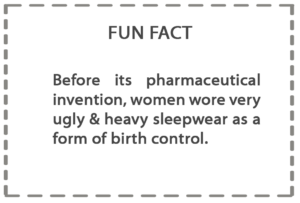 SKIRTS & FRILLS
SKIRTS & FRILLS- Skirts were cut narrower than the prior era
- There was a short train for day wear, & a very long train for evening
- For evening, woman would wear the same skirt they had worn during the day, but change the bodice
- The cuirasse & the princess sheath dress or polonaise (popular 1878-1880) which had a similar line, were cut in one piece
- Cuirasse & Princess Lines were associated with the Prince Princess of Wales (later Queen Alexandra)
- In the late 1860’s to 1870, the princess style relied on the revival of the polonaise, which was a bodice with robe & tie back skirt
- There were two basic designs from which variations were made:
- Style 1: Bodices & skirts were often cut in one on a princess line dress
- The skirt was draped up over an unattached underskirt
- Style 2: gowns that were 2 pieced; bodice & skirt of matching fabric, fitted to natural waist or basque (basque being below the waist in the front and/or back going into a point)
- The 2 piece (Style 2) was sometimes worn as blouse & skirt of contrasting fabric with the blouse loose & tied with a belt or sash
- Style 1: Bodices & skirts were often cut in one on a princess line dress
- The underskirt in all styles was usually trimmed with pleated or gathered flounces, gauged sections, tucking and/or ribbon bands
- Rows of narrow pleated frills called “kilting” were very popular
- Puffs ending in a frill were popular too
- In 1876, although the amount of skirt drapery was the same as in the 1860’s, the draping became more complex
- The overskirt was drawn back, bunched, & puffed into an elaborate arrangements over the rear
- Tapes tied across the inside back of the skirt tightened the front of the skirt
- The overskirt was worn over a supporting bustle or “tournure” as the era progressed
- By 1800 the skirt had become so narrow women had difficulty walking
COLORS & FABRICS
- Overall the outfit was heavily trimmed because trim was mass produced & inexpensive
- Skirts always had extra fabric
- Dresses were for the most part made of one fabric, but with lace or trim for interest
- Gowns were often, however, made of two colors of fabric to show off the many new available dyes
- The two fabrics might be one for the main gown with a different fabric for the drape or overskirt
- Another typical combination was for the one-color dress to have accent fabrics on the bodice front, wrist, skirt, or neckline
- Some color & fabric pattern combinations were rather strange & seemed to modern eye not to match
- Fabrics of choice remained the same as the last eras & included favorites of lightweight lawn, taffeta, silk, silk-taffeta, light wool, & wool blend
- Cotton became a favorite at the end of the 1870’s
- Throughout the era, vivid colors like deep red, peacock blue, bright apple green, royal blue, purple, mandarin, sea green were common & used alone or in combination with tartan plaids
- Evening dresses were in softer hues & very extravagantly trimmed
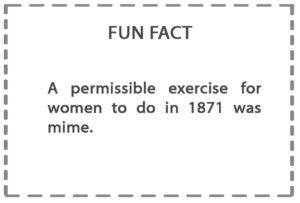
UNDERGARMENTS LATE 1860’s-70’s
- Undergarments were changing, especially night wear because birth control was invented & available
- Women had previously tried to use ugly nightwear as birth control
- In the 1860’s & ’70’s drawers shortened to just below knee level. They were sometimes gathered into knee bands & often had a hip yoke to reduce fullness at the waist
- The version with knee bands became known as “knickerbockers” or “knickers” for short
- Undergarments were typically two pieces; chemise & drawers/knickers, although several types of combination garments were being worn
- Combinations (chemise with pantaloons together) had a wide oval neck & no sleeves. They were fastened with buttons & holes, & the bottoms of the legs were gathered together at the ankle
- Combinations were not buttoned all the way down the back from the neck, so a woman could button herself
- Combinations had a split crotch, with the bulk of fabric across the back to help pad out the back under the petticoat
- Petticoats followed the shape of the outer skirt
- Petticoats were cut with a shaped band to give a smooth line over the hips during the 1870’s
- A petticoat sleeve was cut out along with the body & had a narrow lace edge around it. The lace was also flat to give a smooth line under the bodice
- Red flannel was a favorite of 1850’s to 1860’s petticoats & drawers, but this was replaced by the 1870’s with plain white fabrics
- Newly invented polka dot prints & colored swiss dot fabrics (which had “dots” woven in) were popular for “daring” women’s knickers & pantaloons
UNDERGARMENTS 1870’s-’80’s
- By 1876 the “fishtail” bustle had collapsed, so the skirt & petticoat became sleek & trained, leading the way for the “Princess Petticoat”
- The one-piece “princess petticoat”, named after Princess Alexandra, appeared in the 1870’s
- From the 1870’s into the 1880’s, most petticoats had cascades of flounces or “frills” down the back. This aided in projecting the skirt backwards & masking the steels of the bustle
- The “princess petticoat” bodice was cut in one with the skirt & had no waist seam
- It was high-waisted with a straight silhouette
- Flat lace & ribbon were commonly used on the petticoat
- A horizontal drawstring at the back of the knees held the petticoat in
- Below that, the skirt of the petticoat fanned out into a flounced train that could be detached
- In order to reduce bulk, fashionable women often wore only one petticoat under the dress
- Some wore this one petticoat underneath the corset
- Others wore no petticoat at all, except for a lace flounce tacked inside the dress underskirt which simulated one
- The “princess” was worn over a Combination or chemise with knickers
- The chemise continued to be worn separately from the drawers
- Drawers now reached to just below the knee instead of ankle length
- Drawers had a ruffle with lace & ribbon tie or a frill at the bottom
- Like knickers, the bottom of some drawers were pulled tight below the knee. Some were left open & wide
- Wide knickers would more commonly have a flat lace so they would not make a “bump” on the outside of the dress
- It depended on the skirt design & draping, which type of undergarment would work; whether to aid in giving fullness, protect for modesty, or give a smooth line
- All pants & knickers were split, & had drop button down panels at the top instead of ties or cords as had been in previous eras
- As the era progressed, petticoats were heavily starched again to give skirts their large proportions to support the larger bustle style that would come
- In 1880 a pad was needed to make a good rounded shape since the small bustle was not used
- Some women as 1884 approached added pads & “bum rolls” of padded linen on their rears
- They would wear the pads in addition to the large bustles later
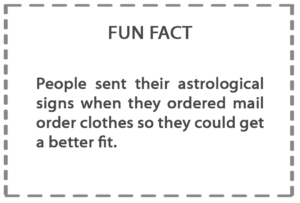
CORSET COVER 1860-1880’s
- When the chemise with the front flap declined in the early 1860’s, the corset cover or under-bodice took its place
- Petticoats had been attached to the bodice for the whole century, but at this time the bodice just separated from the skirt; leaving it otherwise the same
- This separate petticoat bodice was known as a corset cover
- It was either waist length or longer
- The corset cover was front-opening, usually buttoned up the front, & fitted to the figure by means of front darts & sometimes curved side back seams
- The cut of the cover reflected the fashion being worn: it could be sleeveless, short, or long-sleeved
- The cover protected the dress & corset from each other
- It also provided added modesty with gauzy summer & evening dress bodices; preventing the corset from showing at the neckline of the dress or through sheer fabric
- Even though they were not seen because they were worn under clothes, corset covers became increasingly decorative through the 1870’s into the 1880’s
CORSETS 1860’s-1880’s
- Corsets of 1873 were quite stiff, being made of firm couteil fabric & a linen lining which were worked as one heavy piece with heavy cording
- Cording was glued together
- The corset was intricately shaped using multiple pieces (as opposed to the 3 & 4 pieced stays of the 1700’s)
- Although mass produced, there was a huge variety available at a wide variety of pricing
- Corsets starting in 1875 had a longer, sleeker look with a flat stomach & were smooth over the hips
- They would stay this way until corsets were discarded in the next century
- The shaped corset for the first time added PADDING at the bosom to change the silhouette
- Gussets at the bustline provided for a very rounded shape
- All corsets were heavily boned using new metals as well as the older reed & whalebone
- The bust was still emphasized though corsets were little looser through the waist
- This was because the cuirasse bodice did the work of the corset, although not all gowns had a cuirasse
- Gowns without a cuirasse required a more forming corset & tighter waist lacing
- The cuirasse corset was smooth
- The busk had been an innovation of about 1855, intended to give a woman some protection for her lower organs
- The spoon busk, continued to improve & develop. It would in the next era allow women to keep a flat & smooth line on the front of the skirt
- The busk was one of the innovations that marked a change in attitude towards concern for an individual’s health
OUTERWEAR, HAIR & ACCESSORIES
- The “Marcel Wave” hairstyle became popular as curling irons became available for home use at this time
- Hair was otherwise worn in ringlets or natural plaits or braids, unlike the pads & fake hair of prior eras
- Depending on the activity, the braids would be pinned up & around the head, or wound into a bun or chignon
- Women would not cut their hair until the 1910’s as long hair was considered a mark of beauty
- Women would not wear their hair down in this era except in private after they achieved maturing
- 3/4 cloaks & Dolman mantles (a short capelet with wide sleeves that were quite restrictive) were worn to fit over the bustles
- Shawls & short cloaks of previous eras continued to be worn as outwear
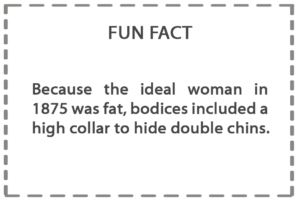

—— ACTUAL GARMENTS FROM THE ERA ——
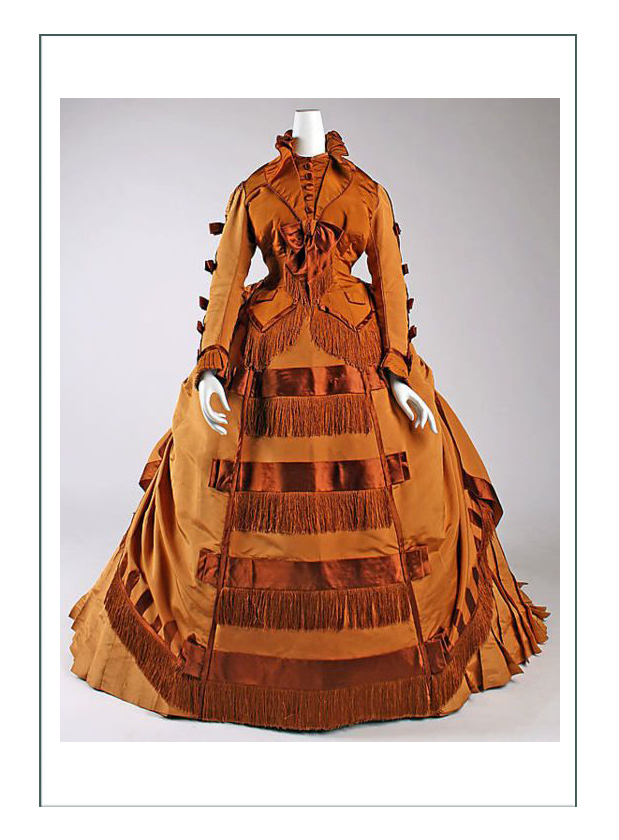
—— (above) “Transitional Gown 1867-71” ——
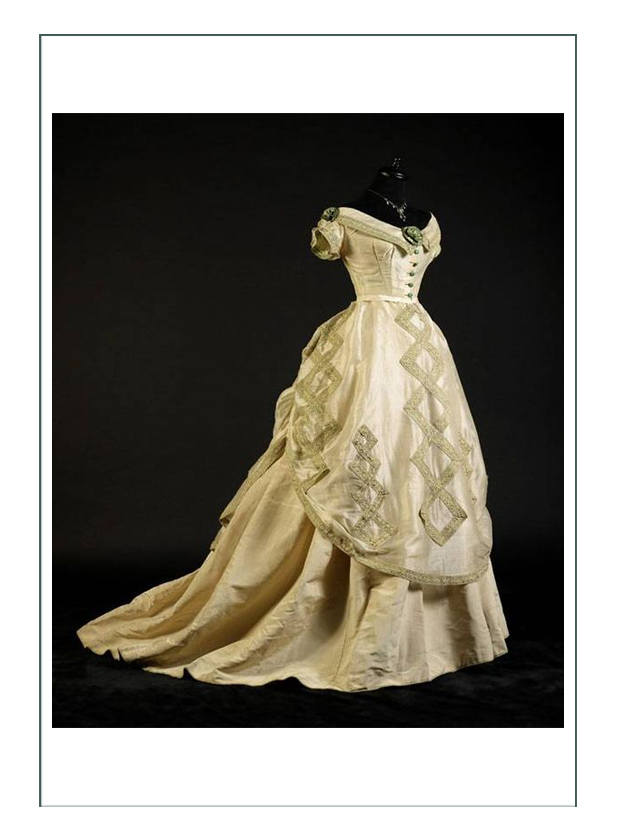
—— (above) “Transitional Bustle 1868” ——
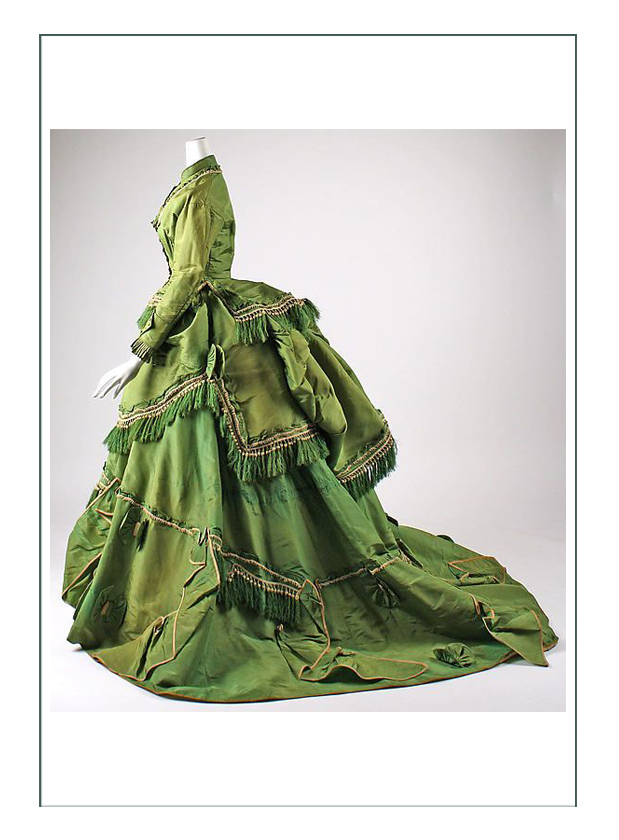
—— (above) “First Bustle 1868” ——
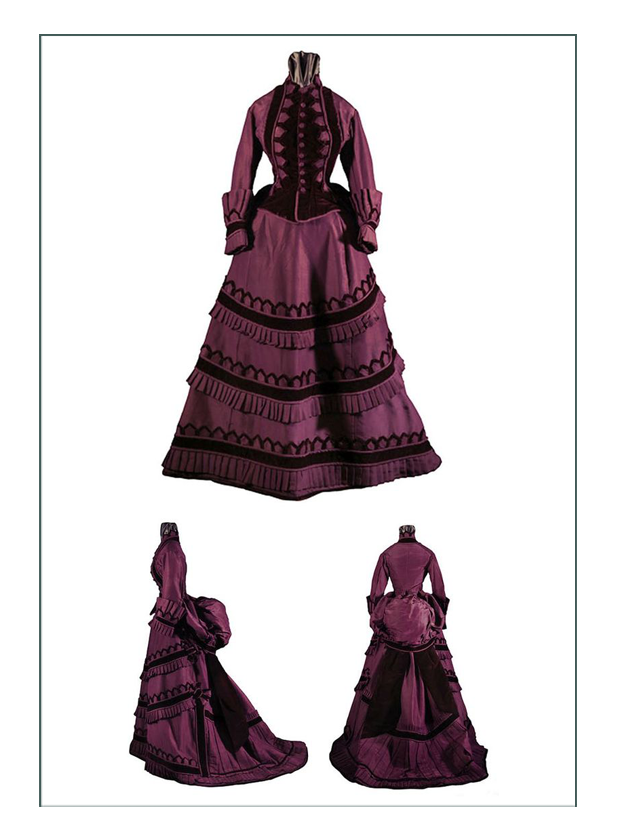
—— (above)“Tea Gown (Bustle Pad) 1870” ——
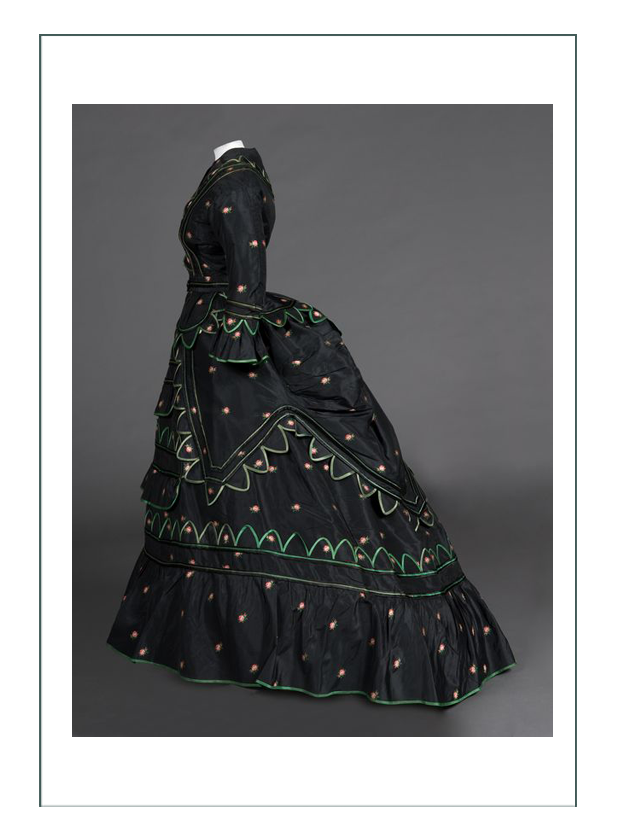
—— (ab0ve) “Cotton Day Dress (1st Bustle) 1870” ——
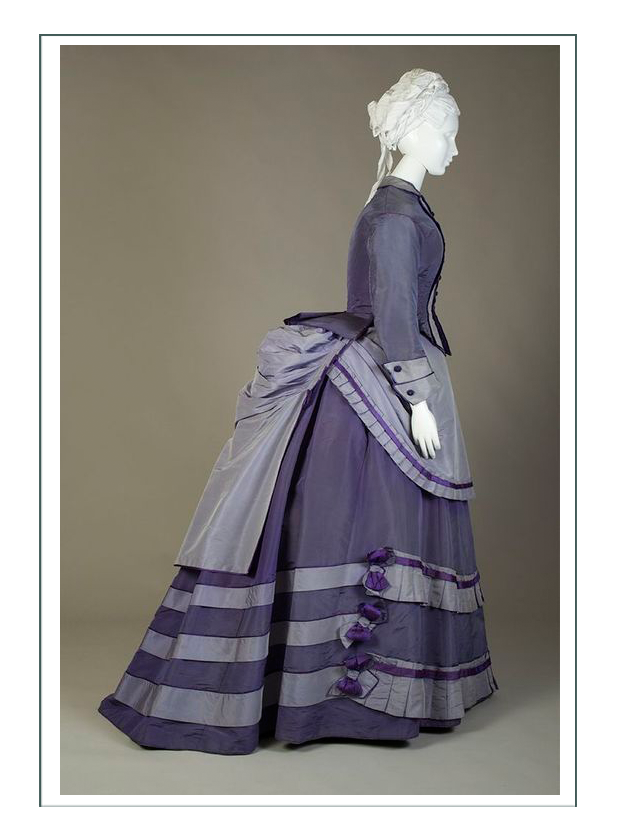
—— (above) “Silk Day Dress (1st Bustle) 1870” ——
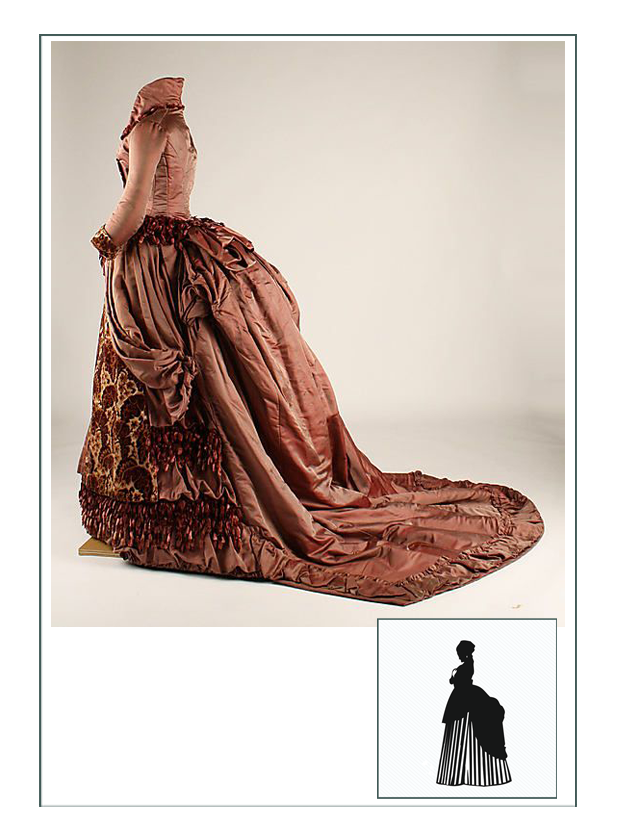
—— (above) “THE Silhouette 1870” ——
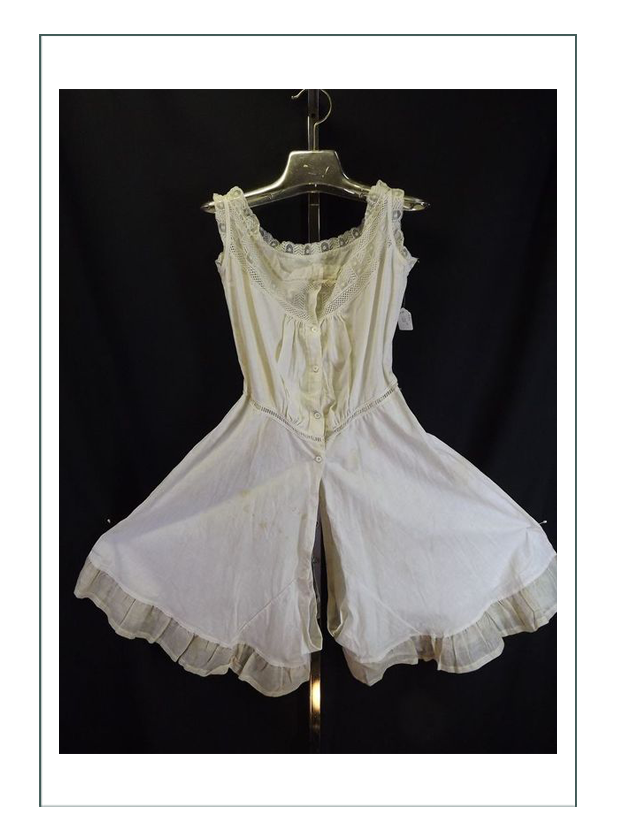
—— (above) “Combination 1870-89” ——
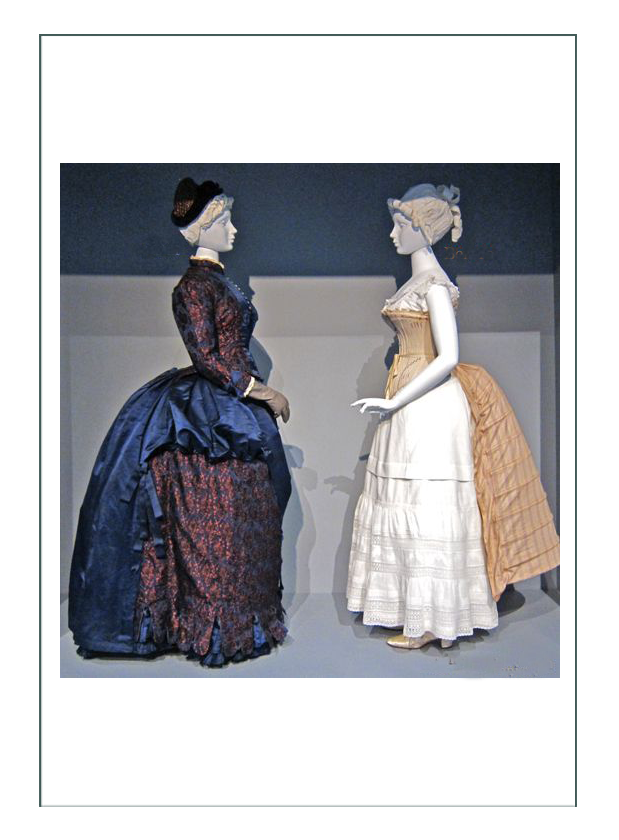
—— (above)“Undergarments 1870-78” ——
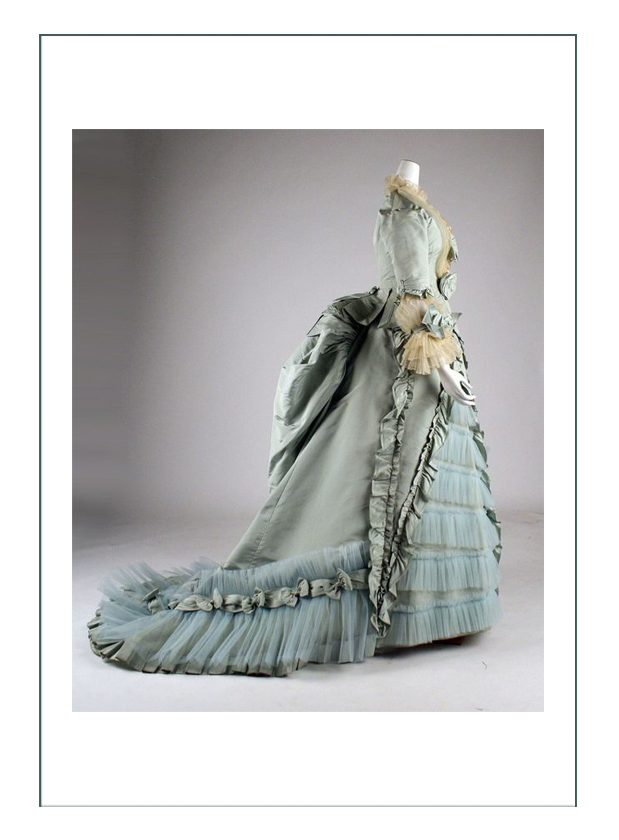
—— (above) “Evening Gown (1st Bustle) 1872” ——
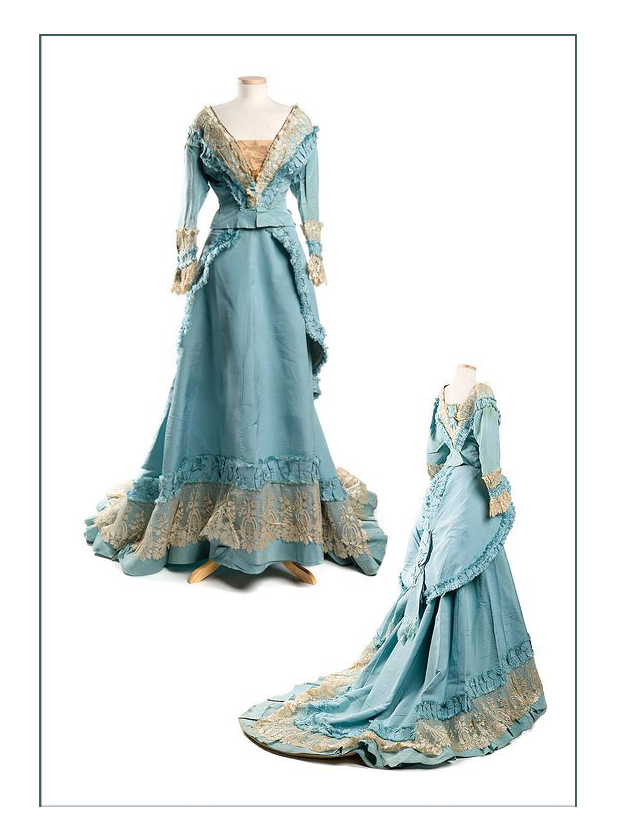
—— (above) “Ball Gown 1872” ——
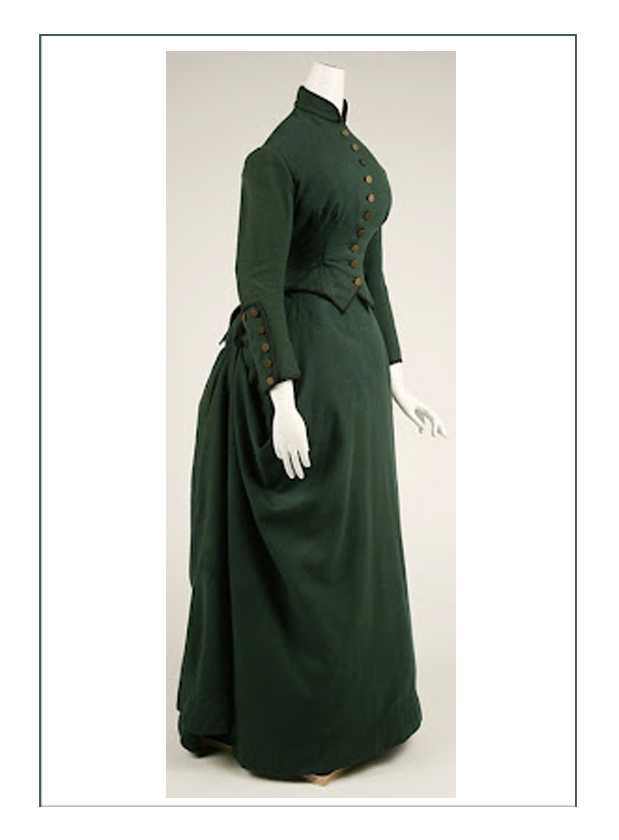
—— (above) “Riding Habit 1872” ——
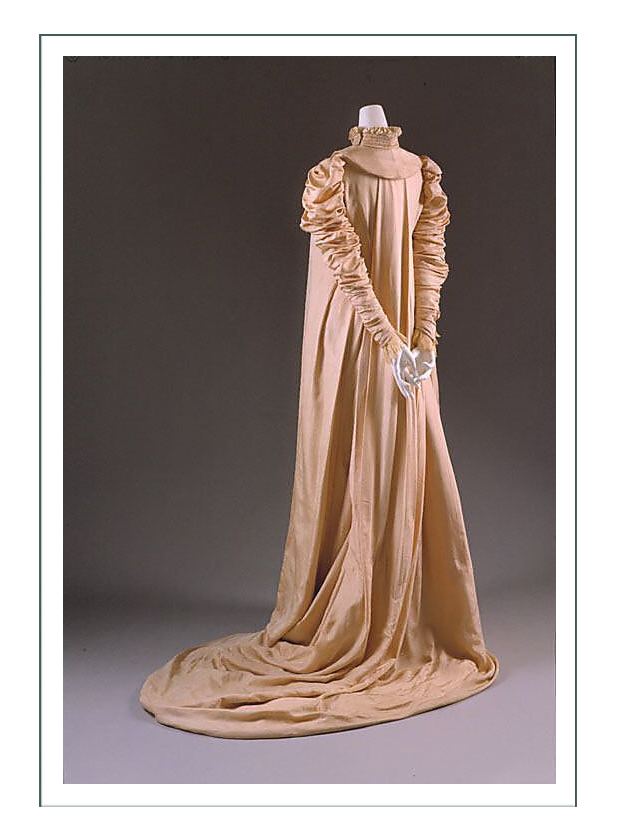
—— (above) Aesthetic Coat by Liberty Company 1875″ ——

—— (above) “Theater Costume (1st Bustle) 1875” ——
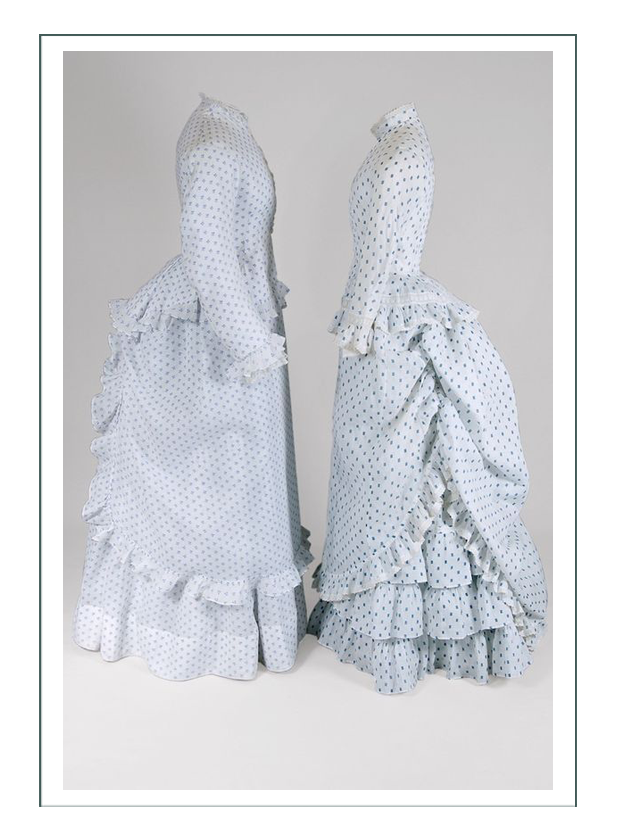
—— (above) “Day Dresses 1875” ——
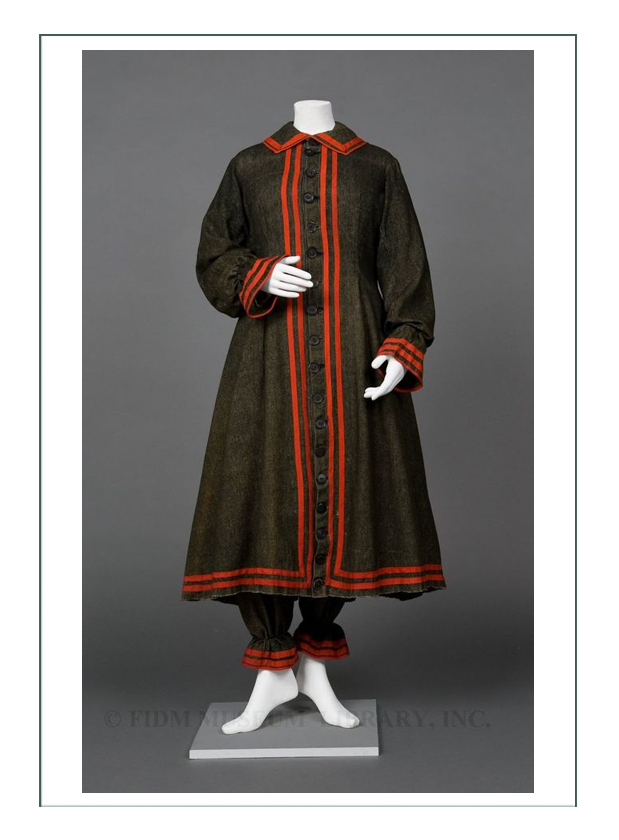
—— (above) “Bathing Costume 1875” ——
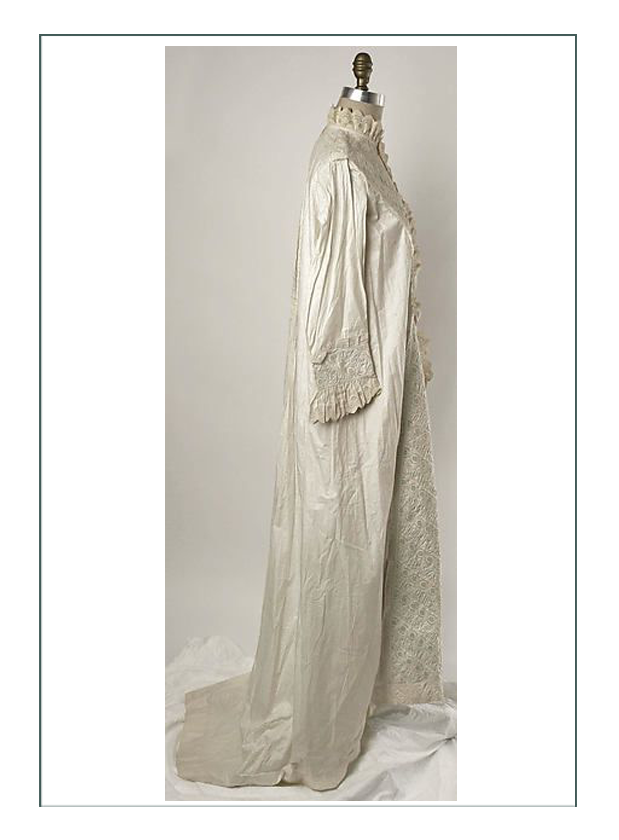
—— (above) “1875 Nightgown 1875” ——
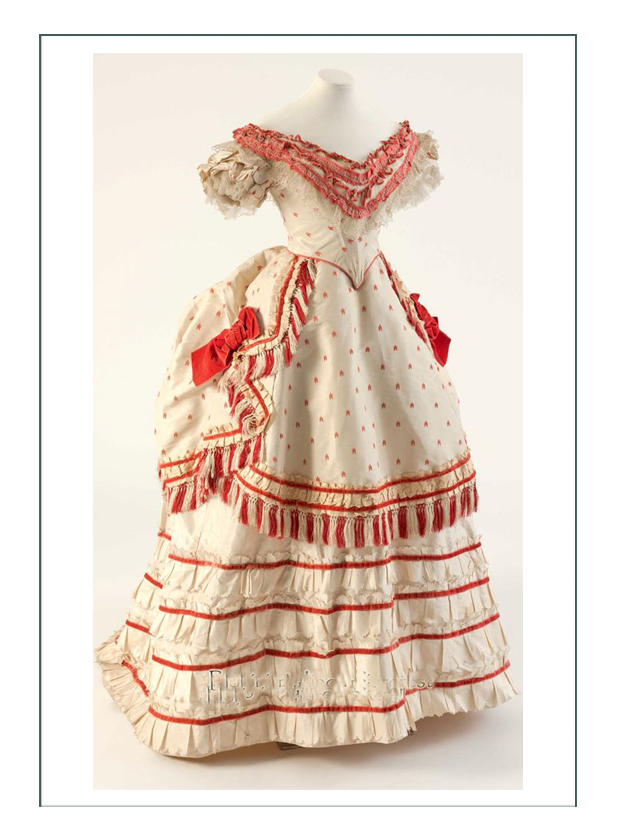
—— (above) “Afternoon Gown 1875” ——
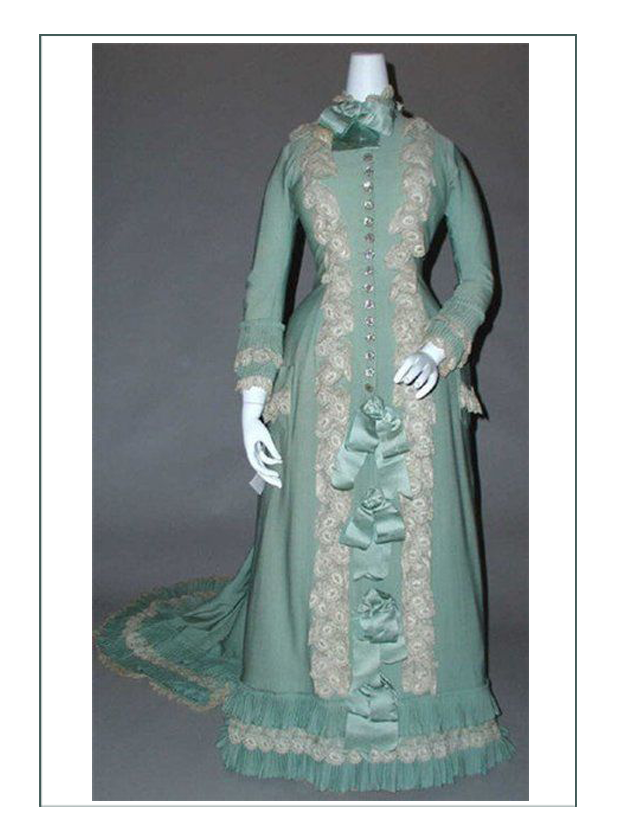
—— (above) “Worth Tea Gown 1875” ——
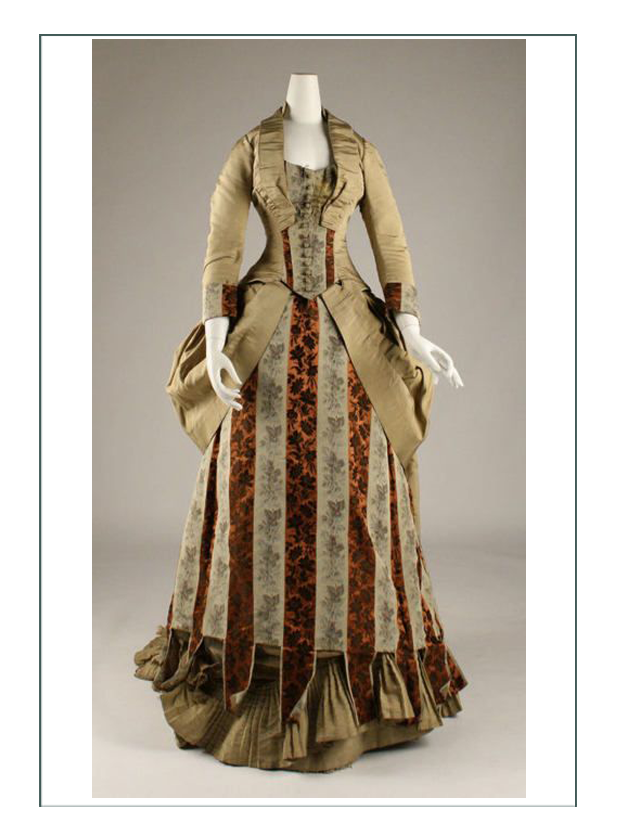
—— (above) “Traveling Ensemble 1876” ——
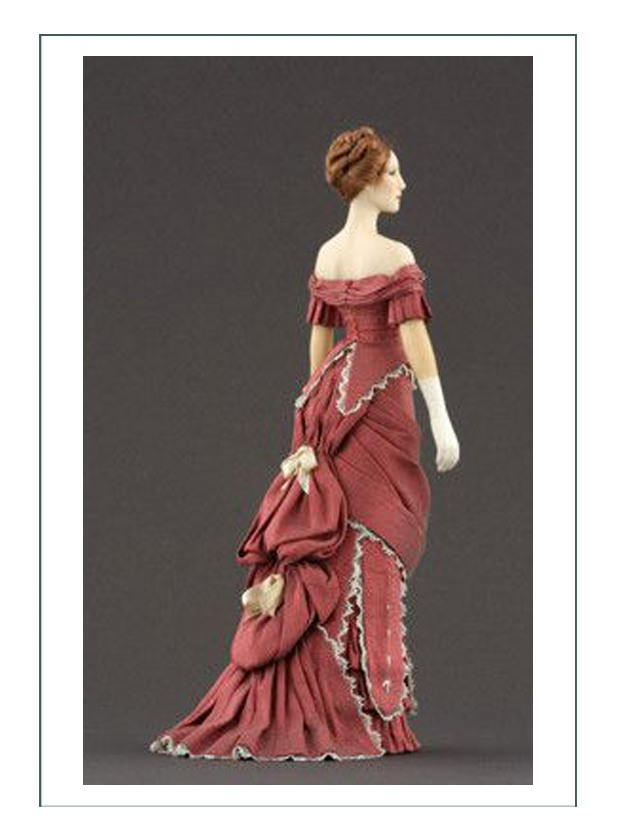
—— (above) “Ball Gown With Fishtail 1878” ——
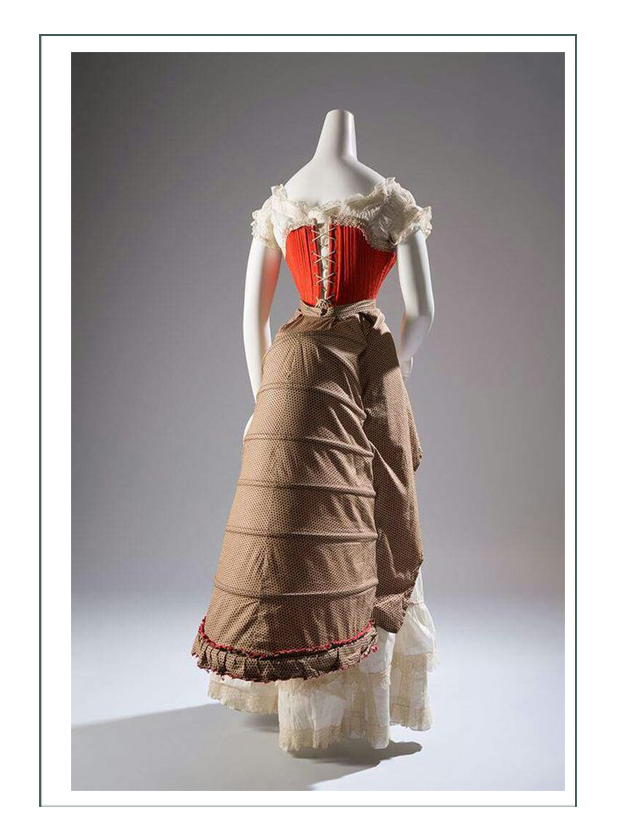 —— (above) “Silk and Steel Bustle 1880” ——
—— (above) “Silk and Steel Bustle 1880” ——
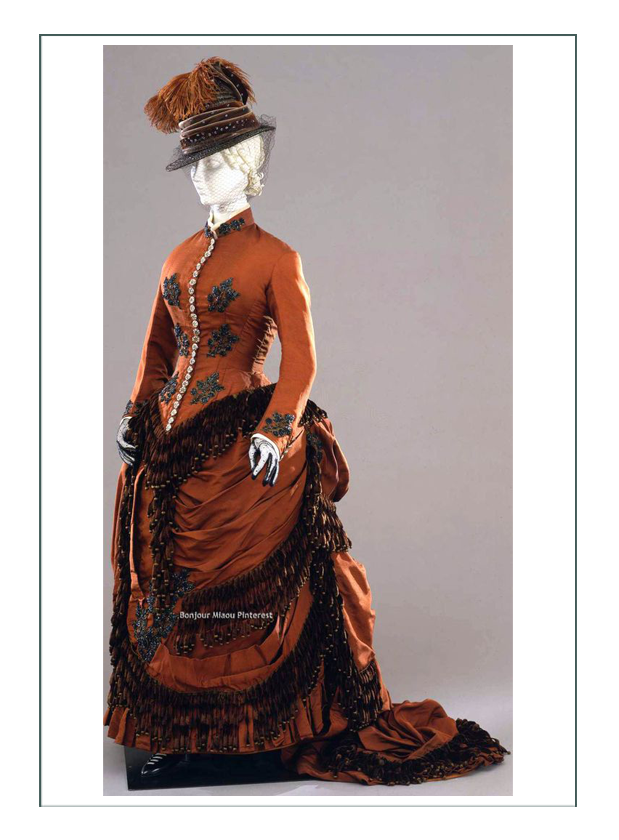
—— (above) “Gown with Train 1880-81” ——
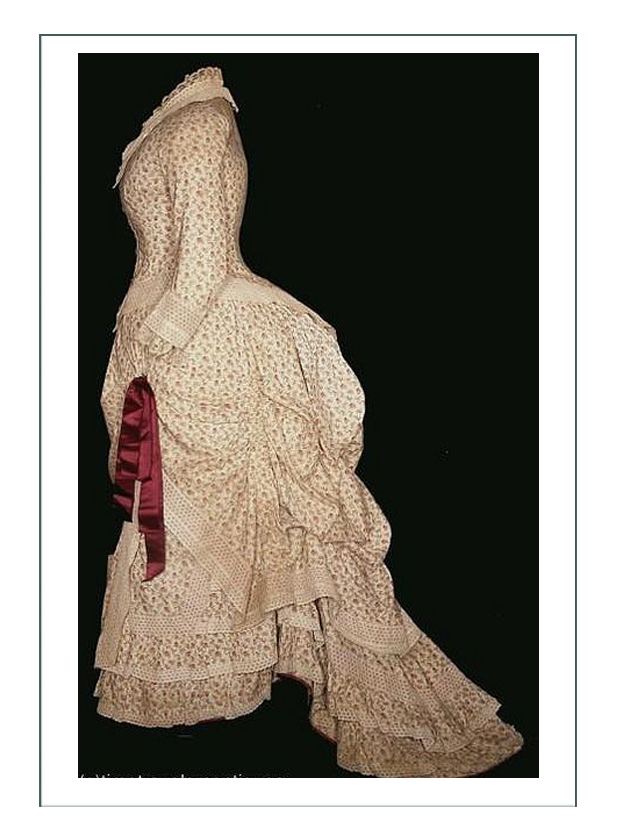
—— (above) “Low Bustle 1880” ——
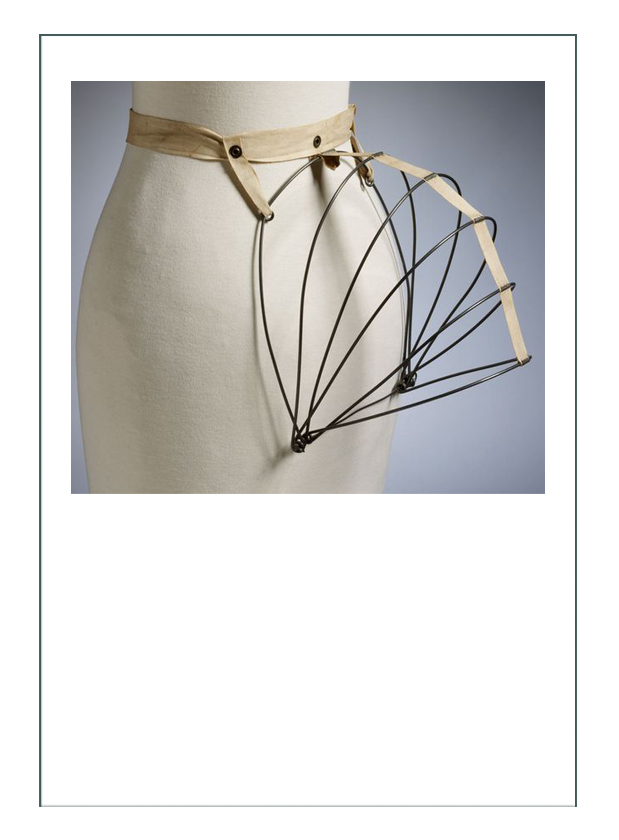
—— (above) “Small Bustle 1880’s” ——
Click date below to go to a different era. We can replicate most ANY garment you see!
